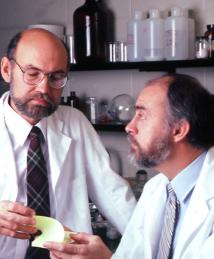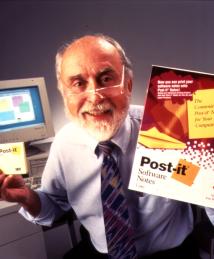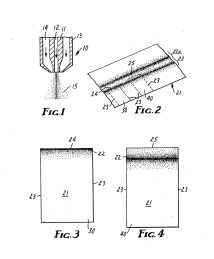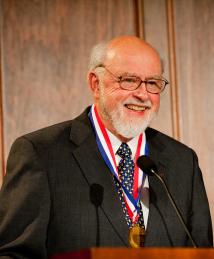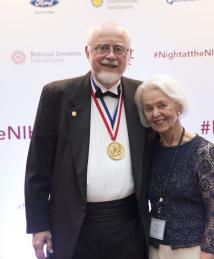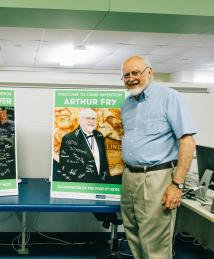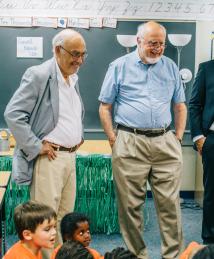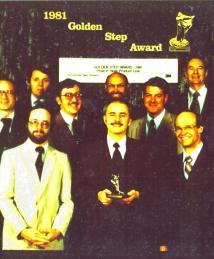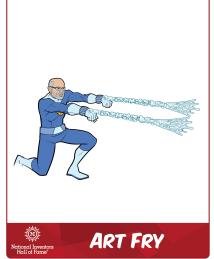Arthur L. Fry
Art Fry and Spencer Silver co-invented Post-it® Notes, which are among the bestselling office products in the U.S.
Fry was born in Owatonna, Minnesota, in 1931. He grew up in a small town in Iowa and in Kansas City, Missouri. Growing up, he enjoyed tinkering and problem-solving projects, such as building a foot-steered bobsled that had runners to go downhill in the winter and wheels to be pulled by his dog in the summertime. He began his educational journey in a one-room rural schoolhouse, and he later returned to Minnesota and completed high school in Duluth.
Fry graduated from the University of Minnesota in 1955 with a bachelor’s degree in chemical engineering. He took a summer job as a technician at 3M Corp. and subsequently spent 40 years with the company as a product development specialist and corporate scientist. He made many technical contributions to 3M products, including art materials, tapes, decorative ribbon and gift wrap, and metal surface-finishing laminates.
During his career at 3M, Fry worked alongside senior chemist and fellow National Inventors Hall of Fame® Inductee Spencer Silver. In 1970, Silver was tasked with exploring and improving acrylate adhesives used for medical, industrial and consumer tapes. He discovered an adhesive consisting of microspheres that were inherently very sticky and long aging. The only problem was that they could not be dissolved nor melted and were not suitable for normal tapes. Over the next five years, Silver shared his newly developed product with his peers at 3M, both informally and through seminar presentations — one of which Fry attended. While most didn’t know what to do with this adhesive, Silver never discarded it.
In 1974, while Fry was singing in a church choir, he grew frustrated that the paper bookmarks he used to mark songs in his hymnal would consistently fall out of sight. He needed adhesive that would stick to paper without damaging it when it was removed. He reasoned that if Silver’s microspheres could be applied in a single layer with proper spacing between spheres, it might work.
When Fry returned to work, he made samples of bookmarks that featured a layer of the microspheres. While using these bookmarks to exchange notes with his supervisor, the colleagues came to realize that these were not just bookmarks – they also could be useful for self-attaching notes, labels and tapes. Fry’s team began writing messages to each other with the prototypes, gradually realizing the product’s potential.
Years of perfecting the product’s design and production followed. Though they encountered major challenges, including creating equipment and processes to manufacture the notes and getting the adhesive to stay in place and maintain a consistent range of adhesion, Fry’s team persevered, and in 1977, the removeable notes were released in four cities under the name “Press ‘n Peel.”
Following a massive marketing effort and a rebranding campaign that produced the now renowned “Post-it Note” name, the product was introduced throughout the U.S. on April 6, 1980. Repositionable notes are now among the five bestselling office products in the country, and when 3M received the National Medal of Technology in 1995, Post-it Notes were named among the products that helped the company earn the award.
In 1983, Fry was admitted into 3M's Carlton Society, the highest honor given to a 3M scientist. Fry said of the product’s success, “It was always a self-advertising product because customers would put the notes on documents they sent to others, arousing the recipient’s curiosity. They would look at it, peel it off and play with it, and then go out and buy a pad for themselves.”
To inspire the next generation of problem solvers, Fry has made personal visits to Camp Invention® program sites, encouraging children to explore their own ingenuity and drive to invent.
In an interview with the National Inventors Hall of Fame, he described how he believes innovation will continue in the future. “We’re all working under a streetlamp. Then somebody goes out in the darkness with a flashlight, and the flashlight is science,” Fry explained. “ You discover something new, and it stimulates all this new stuff. The thing that will keep innovation going is that what we don’t know is so much greater than what we do know. We can’t miss by sending people out in the darkness — it will always work.”
